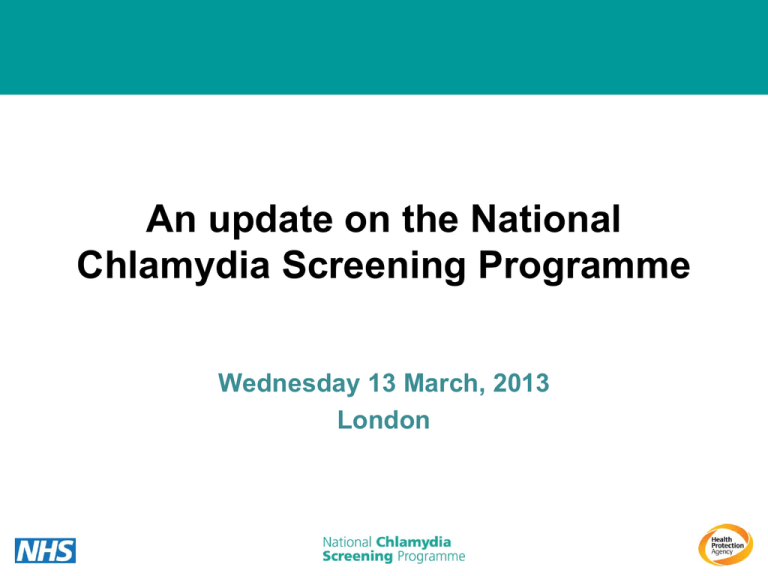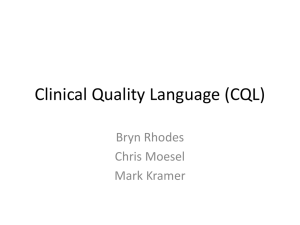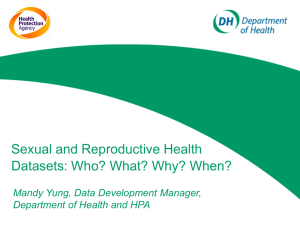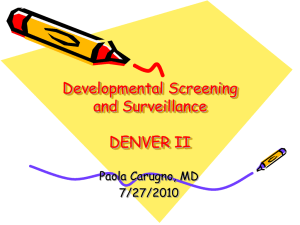
An update on the National
Chlamydia Screening Programme
Wednesday 13 March, 2013
London
Welcome
Dr. Paul Cosford
Director for Health Protection and Medical
Director, Public Health England
Deputy Chief Executive, Health Protection
Agency
Overview of the National
Chlamydia Screening Programme
– challenges, successes and
future direction
Kate Folkard
NCSP Programme Manager
kate.folkard@hpa.org.uk
The National Chlamydia Screening
Programme (NCSP) in England
• Aims to control chlamydia thus reducing
transmission and sequelae
• Opportunistic screening of sexually active < 25
year olds
- Annually
- Change of sexual partner
• Clinical and non-clinical venues
• Routine offer at every consultation
• Standards for treatment and partner notification
The NCSP: achievements to date
• High volumes screened - deliver around 2
million tests and 150,000 diagnoses per year
• Expansion of sexual health services into
community with range of providers
• Early adoption of new technologies
• Quality assurance programme
• Involvement of men
• Reaching those at higher risk and the socioeconomically deprived
What are young people’s views?
•
•
•
•
•
•
•
•
Don’t always see chlamydia as relevant to them
Prefer a blanket approach to testing
Want to be asked rather than have to ask for a test
Don’t want to have to give a sexual history
Need to be sure of confidentiality
Want options – healthcare professional/ ’virtual’ testing
Want results quickly
Want support to be available to manage positive results
Chlamydia Screening and Sexual Health Marketing – COI for DH. Define, 2008
Roles and responsibilities
Trends in chlamydia screening: the
impact of transition?
Decline in screening activity:
• Drop in test volume and
diagnoses over 2011/12
• National diagnosis rate:
1,850 per 100,000 (Jul-Sep’12)
Advice to local areas:
• Maintain sufficient investment in
screening
• Integrate screening within
primary care, SRH and GUM
services (& reduce outreach)
• Ensure repeat screening
annually/change of partner
• Achieve PN standards
Future direction of the programme
• Emphasis on integration and delivery models; embed
within primary care, SRH and GUM services
• Deliver synergies with young adults’ sexual health
interventions such as contraceptive advice, condom use
and wider health promotion
• Chlamydia Testing Activity Dataset (CTAD)
• From coverage target to diagnostic indicator
• Public Health Outcome Framework
• Evaluation framework
Objectives of the day
• To bring together HPA, PHE, public health and
commissioning colleagues with a remit for sexual health
to:
– Present the latest evidence on chlamydia screening
approaches and outcomes
– Provide an update on recent NCSP developments and
future plans
– Ensure confidence in making the case for chlamydia
screening at a local level
– Explore ways to ensure the NCSP can deliver effectively
during the transition year and beyond
Agenda
Workshop Session: Delivering the
NCSP during the transition
30 minute facilitated discussion around three
questions:
• What are the priorities for the NCSP over the
next two years? What do you want to deliver
locally?
• What support do you need from NCSP nationally
to deliver?
• Who is going to help you deliver at a local level /
what are your new emerging local network?
The chlamydia screening evidence
base – overview
Kate Soldan
kate.soldan@hpa.org.uk
• Common sexually transmitted
infection
• Majority of infections are
asymptomatic
• Highest rates of infection among
young people
• Easy to detect using NAAT tests
• Easy to treat with antibiotics
Chlamydia infected culture (Wellcome Images)
Chlamydia trachomatis
Rationale for chlamydia screening
• Chlamydia infection is a known risk factor for a number
of serious health problems:
–
–
–
–
–
Pelvic inflammatory disease
Ectopic pregnancy
Tubal factor infertility
Neonatal pneumonia and neonatal conjunctivitis
Epididymitis in men
• Treating chlamydia infections prevents the development
of sequelae
– RCT showed 83% reduction in PID among treated
compared to untreated chlamydia infection (p>0.05)[1]
[1] Oakeshott et al. BMJ 2010;340:c1642
Rationale for chlamydia screening
• Asymptomatic screening to detect
chlamydia trachomatis should:
– Reduce the prevalence and incidence of
infection
– Reduce the risk of developing health
problems
What do we want to know?
• Impact of widespread screening for
asymptomatic chlamydia infections on
– Prevalence and incidence of chlamydia
– The incidence of complications
– Young adults’ sexual health and wellbeing
• The predicted impact
• The impact in practice
What do we want to know?
• Optimal models of service delivery
– Partner notification
– Testing frequency
– Testing the right people
– Sustainable service configuration
• Cost effectiveness
The evidence base on outcomes
of chlamydia screening
Reducing transmission and
prevalence
Sarah Woodhall
sarah.woodhall@hpa.org.uk
How should chlamydia screening affect
prevalence and incidence?
• Asymptomatic screening to detect
chlamydia trachomatis (plus subsequent
partner notification) should:
– Reduce prevalence of infection by removing
cases from the pool of infections
– Identify infections earlier in the course of
infection
– Reduce incidence of infection by preventing
onward transmission to sexual partners
Natural course of chlamydia infection
Infection
End of infection
without
screening
Natural clearance
Develop
symptoms/complications,
treated
Screening reduces the duration of infection
Infection
End of infection
with screening
End of infection
without
screening
Natural clearance
Screening
test
Develop
symptoms/complications,
treated
Chlamydia screening can prevent transmission
End of infection
without
screening
Infection
Natural clearance
Chlamydia passed
on to sexual partner
Develop
symptoms/complications,
treated
Chlamydia screening can prevent transmission
Infection
End of infection
with screening
End of infection
without
screening
Natural clearance
Screening
test
Chlamydia not passed
on to sexual partner
Develop
symptoms/complications,
treated
What do we know about the impact of chlamydia
screening on prevalence and transmission in practice?
•
•
•
•
Mathematical modelling
Randomised controlled trials
Analysis of routinely collected data
Prevalence surveys
What do we know about the impact of chlamydia
screening on prevalence and transmission in practice?
•
•
•
•
Mathematical modelling
Randomised controlled trials
Analysis of routinely collected data
Prevalence surveys
Chlamydia prevalence (%)
Chlamydia prevalence among 16-24 year olds:
Modelling the effectiveness of screening
Testing coverage: 9%
Testing coverage: 26%
Testing coverage: 43%
Years after introduction of the screening programme
NAO, 2009. Based on: Turner et al. STI 2006
Key assumptions: Baseline prevalence 6.5%; PN 20%; few cases
treated in absence of screening programme
What do we know about the impact of chlamydia
screening on prevalence and transmission in practice?
•
•
•
•
Mathematical modelling
Randomised controlled trials
Analysis of routinely collected data
Prevalence surveys
• RCT among >300,000 16-29
year old men and women
4.0%
3.0%
• Annual postal invitation to
chlamydia screening for 3
years
2.0%
• Lower than expected uptake
(10% -16%)
Amsterdam
Van den Broek et al. BMJ 2012
Rotterdam
Control
3rd invitation
2nd invitation
1st invitation
Control
3rd invitation
2nd invitation
1st invitation
Control
3rd invitation
0.0%
2nd invitation
1.0%
1st invitation
Estimated prevalence
Randomised controlled trial of chlamydia
screening, Netherlands
South Limburg
• No significant fall in
prevalence was observed
• some evidence for a fall
in South Limburg
Ongoing randomised controlled trials of
chlamydia screening
• Australia
– The Australian Chlamydia Control
Effectiveness Pilot
(www.accept.org.au)
– Randomised controlled trial of
chlamydia screening in primary care.
• Finland
– Cluster randomised controlled trial as
part of an HPV vaccine trial
What do we know about the impact of chlamydia
screening on prevalence and transmission in practice?
•
•
•
•
Mathematical modelling
Randomised controlled trials
Analysis of routinely collected data
Prevalence surveys
3500
3000
2500
2000
1500
1000
500
GUM
NCSP
2011
2010
2009
2008
2007
2006
2005
2004
2003
2002
2001
2000
1999
0
1998
Diagnosis rate/100,000 population
Chlamydia diagnosis rate (per 100,000 pys),
15-24 year old females
NNNG
GUM diagnoses represent uncomplicated CT; NNNG (Non-NCSP, non-GUM) diagnoses available from April 2008 onwards.
GUM data as at Feb 2013; NCSP/NNNG data as at November 2012
Number of tests and proportion testing
positive by gender (NCSP tests)
1,000,000
900,000
20%
800,000
700,000
15%
600,000
500,000
10%
400,000
300,000
5%
200,000
100,000
0%
0
2003 2004 2005 2006 2007 2008 2009 2010 2011
Total tests (F)
Total tests (M)
% positive (F)
% positive (M)
Number of tests
Proportion testing positive
25%
Number of tests and proportion testing
positive by gender (NCSP tests)
1,000,000
900,000
20%
800,000
700,000
15%
600,000
500,000
10%
400,000
300,000
5%
200,000
100,000
0%
0
2003 2004 2005 2006 2007 2008 2009 2010 2011
Total tests (F)
Total tests (M)
% positive (F)
% positive (M)
Number of tests
Proportion testing positive
25%
What do we know about the impact of chlamydia
screening on prevalence and transmission in practice?
•
•
•
•
Mathematical modelling
Randomised controlled trials
Analysis of routinely collected data
Prevalence surveys
Population based prevalence surveys
• United States
– National Health and Nutrition Examination Survey
– Includes urine test for chlamydia
• UK
– National Surveys of Sexual Attitudes and Lifestyles
• Chlamydia prevalence in 2000 and ~2010
• Comparability between survey years limited
– Pilot postal survey among young women conducted in
2 PCTs in 2011[1]
• Low response rate, therefore open to substantial bias
• Unlikely to be a feasible or appropriate method of
monitoring prevalence over time
[1]Woodhall
et al, Under review
Summary
• In the absence of changes in any other risk factors,
chlamydia screening should reduce the prevalence and
incidence of chlamydia
• Mathematical modelling and routine data are consistent
with a fall in chlamydia prevalence in recent years
• No empirical evidence to demonstrate a fall in
prevalence
• Changes in chlamydia in the context of testing and
trends in other STI will become more informative in the
future
Preventing sequelae
Kate Soldan
kate.soldan@hpa.org.uk
Chlamydia is an important cause of
reproductive health problems in women
Ectopic
Pregnancy
7.6%
Chlamydia
infection
1% / 10% / 30%
Pelvic
Inflammatory
Disease
10.8%
Tubal Factor
Infertility
Source: Adams et al. STI 2007; 83;267-275
Chlamydia is an important cause of
reproductive health problems in women
• ~10% to 20% risk of developing PID after
a chlamydia infection[1,2]
• ~45% of tubal factor infertility is caused by
chlamydia[3]
[1] Oakeshott et al. BMJ 2010;340:c1642; [2] Price et al. Am J Epi. In press; [3] Price STD 2012;39(8)
Can chlamydia screening prevent PID?
Chlamydia screen
PID
Chlamydia
infection
PID not
prevented
PID
prevented
Can chlamydia screening prevent PID?
• Synthesis of published studies has
estimated that
– ~41% to 61% of chlamydia-related ‘PID’ can
be prevented by annual screening[2]
• Three randomised controlled trials have
evaluated the effect of a single round of
chlamydia screening on PID 1 year later
[2] Price et al. Am J Epi. In press
One-year incidence of PID
Can chlamydia screening prevent ‘PID’?
5%
56% risk
reduction
(p<0.05)
51% risk
reduction
(p<0.05)
35% risk
reduction
(p>0.05)
4%
3%
Intervention
Control
2%
1%
0%
Scholes, 1996
Ostergaard,
2000
Oakeshott, 2010
[4] Scholes NEJM:1996;334:1362-6; [5] Ostergaard CID:2000;31:951–7; [6] Oakeshott BMJ:2010;340:c1642
Rate of PID diagnoses in General Practice by
definition (Females 16 to 44 years old)
Source: French et al. STD 2011: 38(3):158-62
Rate of PID diagnoses* in General Practice by age
group (Females 16 to 44 years old)
*Definite/probable PID diagnoses
Source: French et al. STD 2011: 38(3):158-62
Summary
• Asymptomatic screening to detect
chlamydia trachomatis can prevent the
subsequent development of sequelae
• The proportion of PID and ectopic
pregnancy episodes that can be prevented
by screening depends on
– levels of screening
– natural history of infection
NCSP web survey 2012 –
Attitudes to chlamydia screening
and subsequent impact on behaviour
Chlamydia Operations Group
13 Mar 2013
Tom Hartney, Paula Baraitser, Anthony Nardone
Sexual Health Promotions Team
thomas.hartney@hpa.org.uk
Web survey background
• Little data on attitudes of young people to chlamydia
screening
• Qualitative study reported generally positive attitudes1
• Little information on impact of screening on subsequent
behaviour. Self-reported changes in sexual behaviour
following a positive result for STIs:
• Increase of condom use post-treatment for STIs2,3.
• Decrease in sexual partners2
1 Hogan et al 2010; 2 Sznitman et al 2009; 3 Fortenberry et al 2002
Aims
• Aim: to inform the development of the NCSP through a
survey of young people, both tested and non-tested.
• What are young people’s attitudes towards chlamydia
and chlamydia testing?
• What impact does being tested have on future
behaviour?
Methods
• Web-based cross-sectional anonymous survey
• Used panel of young people accessed via market
research company (small incentive, <£1)
• Eligibility criteria:
– Aged between 16-24
– Resident in England
– Representative by age, sex and region
• Questionnaire took around 20 minutes, covered
–
–
–
–
Testing history
Sexual behaviour
Demographics
Attitudes and impact of testing on behaviour
Results
• 1,521 responses over 2 weeks in June 2012
• Demographically weighted sample: 51% male, 81% white
• 46% ever tested (29% in last year)
– 57% of these tested more than once
– 13% had had a previous positive result
• 11% had >1 partner in last year (39% among tested)
• 29% had unprotected sex in last 3 months (61% among
tested)
• 70% of those not tested didn’t consider themselves at risk
Assessing attitudes
• Questions use framework of Theory of Planned Behaviour
• Likert scale 1-5 (strongly disagree to strongly agree)
“Please read the following statements and decide to what extent
you agree or disagree with each of them...”
•
•
•
•
•
•
“I should get tested for chlamydia every year if I am sexually active”
“Getting tested for chlamydia is a normal part of young people’s lives”
“My friends get tested for chlamydia”
“Chlamydia is a problem that does not concern me”
“I would be too embarrassed to ask for a chlamydia test”
“Only people who sleep around get chlamydia”
Attitudes towards chlamydia and testing
Attitudes by testing status
Combined attitudes scores
• Each statement either positively or negatively associated with
testing
•
•
•
•
•
•
“I should get tested for chlamydia every year if I am sexually active”
“Getting tested for chlamydia is a normal part of young people’s lives”
“My friends get tested for chlamydia”
“Chlamydia is a problem that does not concern me”
“I would be too embarrassed to ask for a chlamydia test”
“Only people who sleep around get chlamydia”
• Level of agreement used to score each response from -2 to +2
• Combined to form overall attitude score for each respondent
Proportion tested by combined attitude score
Behavioural questions
“Would you say that having been tested for chlamydia has made
you more or less likely to...”
(1 = “Much less likely” to 5 = “Much more likely”)
•
•
•
•
•
•
•
•
•
Know how to avoid getting chlamydia
Discuss contraception with a new partner
Use condoms every time I have sex
Ask a new partner to have a test for chlamydia?
Have fewer sexual partners
Discuss my sexual health with a nurse or doctor
Test for chlamydia again in future
Ask my GP or practice nurse for a chlamydia test
Recommend a chlamydia test to a friend
Impact of testing of future behaviour
(n=695)
Impact by test result
Impact by time since last test
Conclusions
•
•
•
•
•
Positive attitudes towards chlamydia and chlamydia testing are
strongly associated with being tested
More than half (55%) of those never tested agree that they should
be tested every year
Majority of young people report that testing has a positive impact
on their behaviour
More impact on health-care seeking than sexual behaviour
– positive result: more impact on condom use and discussing
sexual health with professionals
– recent testing (<3 months): more impact on partner numbers
Repeat of survey in summer 2013:
–
–
track changes over time
explore impact of testing in more detail
Thank you
thomas.hartney@hpa.org.uk
Framework:
The Theory of Planned Behaviour
Lunch
Chlamydia Testing Activity Dataset (CTAD)
Update and future plans
Dr Nicky Connor
Consultant Epidemiologist, CTAD
Nicky.connor@hpa.org.uk
Where does chlamydia data come from?
How do national NCSP and CTAD
chlamydia diagnosis rates compare?
How do regional NCSP and CTAD
chlamydia diagnosis rates compare?
How many laboratories submit CTAD data?
Number of laboratories submitted data by 06.03.2013 England, by quarter:
*estimate
Number of missing laboratory submissions per quarter by region
How easily can we assign tests by
area of residence?
Proportion of valid postcode of residence available for non-GUM samples for
each region by quarter
How can we improve local data?
What NCSP data will be available?
What reports will you be able to create on the
web portal?
What routine quarterly reports will there
be?
Making CTAD a success
• New data system at a time of change
• Improve data quality - testing services and
laboratories
o
Postcode of residence
o
Testing service type
• Success
o
Easier to collect data
o
Better data
o
Inform commissioning
Thank you!
•
•
•
•
•
•
•
•
•
•
•
Laboratories
Testing services
Sexual health commissioners
HPA sexual health leads
HPA Regional information managers
Chlamydia screening officers
Sexual health facilitators
GUMCAD surveillance team
CTAD surveillance team
NCSP team
All other contributors
The evidence base on
implementation issues
Internet testing for Chlamydia
trachomatis in England, 2006 to 2010*
Sarah Woodhall
sarah.woodhall@hpa.org.uk
*Woodhall et al. BMC Public Health 2012;12:1095
Background
• The NCSP offers free chlamydia tests to
under 25 year old men and women in
England
• Testing services are delivered locally
• Chlamydia tests are available from testing
venues, for example:
– General practice
– Sexual and reproductive health services
– Non-clinical venues including the internet
The internet testing pathway
Please call
us to get
your
chlamydia
test result.
Laboratory
Aims
• To describe online access to chlamydia
testing within the NCSP
• To evaluate websites offering testing in
terms of signposting and health promotion
advice
Methods (1)
• Data source
– NCSP chlamydia testing data, 2006 to 2010
– 15-24 year old men and women
– 71/95 programme areas with available data
• Compared reported characteristics for test
from three settings (2010):
– Internet tests
– General Practice (GP) clinics
– Sexual and reproductive health services (SRH)
Methods (2)
• Identified websites offering chlamydia
tests:
– Free chlamydia tests through the NCSP
– Tests offered on a commercial basis
• Evaluated websites:
– Signposting to clinical services
– Health promotion information
9.0%
8.0%
7.0%
6.0%
5.0%
4.0%
3.0%
2.0%
1.0%
0.0%
70,000
60,000
50,000
40,000
30,000
20,000
10,000
0
2006
2007
2008
2009
2010
Number of tests accessed through internet
Proportion of tests accessed through internet
Proportion of NCSP diagnoses made through internet tests
*Includes 71 programme areas (covering 111 PCTs) with specific codes for tests accessed through the internet.
Number of tests
Proportion of tests/diagnoses
What proportion of NCSP tests are carried
out through the internet ?
What proportion of NCSP tests were carried out
through the internet in each programme area?
(2010)
Proportion of NCSP tests
contributed by internet tests
40%
35%
30%
25%
Contribution of Percentage of
internet tests programme areas
Under 2%
30%
2% to <10%
40%
10% to 38%
30%
20%
15%
10%
5%
0%
Programme areas
*Includes 71 programme areas (covering 111 PCTs) with specific codes for tests accessed through the internet.
What proportion of tests were positive?
Proportion testing positive
12%
9.9%
10%
8%
8.1%
8.0%
7.3%
5.7%
6%
5.6%
4%
2%
0%
Internet
GP
Males
SRH
Internet
GP
Females
SRH
Who accessed chlamydia tests in each setting?
70%
60%
50%
40%
30%
20%
10%
0%
Male
Aged 20-24 Non-white
ethnicity
Internet
Living in
more
deprived
area
GP
New SP in >1 SP in past
past 3
12 months
months
SRH
*Proportions presented among those with available data. GP=General practice ; SRH= Sexual and Reproductive Health Services
Health promotion information and signposting
NCSP
websites
(n=58)
Commercial
services
(n=32)
Condom use
85%
29%
Contraception
33%
0%
How to access other STI
tests
47%
60%
Signposting if symptomatic
79%
32%
N=58 NCSP websites; 32 commercial websites
Summary
• Internet testing is an important component of
chlamydia control
• Access to free chlamydia testing via the internet is
widely available in England
– But fragmentation and duplication of services is a
problem
• Internet testing reaches a population with a high risk
of chlamydia (e.g. men, higher risk sexual behaviour)
• Websites should signpost to clinical care and health
promotion information
• Routine audit tools now under development
Repeat testing after a positive test for
chlamydia
Sarah Woodhall
sarah.woodhall@hpa.org.uk
Question
• Should the NCSP routinely recommend
repeat testing following a positive
chlamydia test result?
Overview
• Current NCSP policy related to repeat chlamydia
testing
• Summary of available evidence relating to
repeat chlamydia testing
–
–
–
–
–
Risk of re-infection
Current repeat testing patterns
Different approaches to repeat testing
The role of reinfection in relation to other interventions
Acceptability and cost
Current pertinent NCSP policy
• Opportunistic screening
in a variety of venues
• Screening annually and
on change of partner
• Sexual health advice for
all
• Treatment and partner
notification standards
• No routine ‘test of cure’
Incidence/re-infection rate
per 100 person years[1]
Risk of re-infection following a positive
chlamydia test
50
40
30
20
10
0
GP
FP clinics
GUM
clinics
Young people who test
positive for chlamydia
are at higher risk of
subsequently testing
positive for chlamydia[1-3]
Study setting
Incidence (following negative test)
Re-infection
[1]Lamontagne. STI 2007; [2] PLoS.One. 2012;[3] Batteiger JID. 2010
Proportion testing positive at repeat
test
Risk of re-infection following a positive chlamydia
test
25%
20%
19.4%
17.0%
15%
12.5%
High rates of re-infection
have been consistently
reported in several
settings[4-8]
10%
5%
0%
GUM NCSP tests, Cornwall,
clinics,
2010 [4] 2003-2009
2010 [4]
[8]
After negative test
After positive test
[4] Woodhall STI 2012; [5] Turner STI 2012; [6] Rietmeijer
STD 2002; [7] Hosenfeld STD 2009; [8] Fung STI 2007
Systematic reviews show:
• median of 14% of women
re-infected at repeat test[7]
• median of 11% of men
infected at repeat test[8]
Impact on progression to sequelae, chlamydia
incidence and prevalence
• Data from observational studies and mathematical
models suggest that:
– Repeat chlamydia infections are associated with an increased
risk of adverse sequelae[9,10]
– Re-infections within existing sexual partnerships are likely to be
important in maintaining levels of chlamydia prevalence[11]
• There is limited evidence on the potential impact of
increasing repeat testing on the incidence or prevalence
of chlamydia or on the development of chlamydia-related
sequelae
– Could assume to be at least as beneficial as diagnoses made
through asymptomatic screening
[9] Haggerty et al. JID 2010;201 Suppl 2:S134-S155; [10] Darville et al. JID 2010;201 Suppl 2:S114-S125; [11] Heijne et al. JID
2011;203:372-7
re-testing
proportion
Cumulative
0.00
0.10
0.20
0.30
Current practice:
Repeat testing rates in England
Moderate rates of repeat testing
already occur among young adults in
England[12]
- NCSP: 18 per 100 pys (see figure)
- GUM clinics:26 per 100 pys
0
4
8
12
16
20
24
28
32
36
40
44
48
52
Rates of repeat testing are 25% to
50% lower than might be expected if
all young people were re-tested on
change of sexual partner[12]
Number
of weeksfrom
from baseline
test test
Number
of weeks
baseline
Male, negative at baseline test
Male, positive at baseline test
Female, negative at baseline test
Female, positive at baseline test
Cumulative proportion re-testing after 6
weeks, NCSP tests 2010
[12] Woodhall et al. STI 2013;89(1):51-6
The number of infections that would be
diagnosed in addition to existing
testing patterns has not been
demonstrated in practice
Current practice:
Delivery models
• Scoping exercise, 19 services (CSP, GUM, SRH)
• Identified a range of existing recommendations
and service delivery models
–
–
–
–
–
–
–
No recommendation
Repeat test recommended, but no active recall
Repeat appointments
Text messages, telephone or letter reminders
Mailed testing kits
Varying intervals
Some categorisation by complexity of patient
International experience:
Uptake rates by different approaches
Uptake of repeat tests
70%
60%
50%
40%
30%
20%
10%
Not stated
… … … … Phone, letter,
Financial
incentive
… … ……
Guideline
…
Motivational
interviewing
0%
…Mailed
…
test kits
[13] Guy . STI 2013; [14] Downing STI 2013; [15] Dukers-Muijrers STI 2012; [16] Hoover CID 2012; [17] Gindi . Ntnl STD Prevention Conference.
Philadelphia, PA, 2004; [18] Malotte STD 2004;31:637-42; [19] Paneth-Pollak . STD 2010;37:365-8; [20] Gudgel . National STD Prevention Conference
2006; [21] Kohn . Ntnl STD Prevention Conference 2010; [22] Xu . Obstet.Gynecol. 2011;118:231-9; [23] Sparks . STD 2004;31:113-6.
Time between treatment and repeat testing
• The optimum interval for repeat testing has not
been established
• This will depend on logistical and biological
considerations
Country
USA
Canada
Australia
New Zealand
Scotland
Recommended re-testing interval
Approximately 3 months
6 months
3 months
6 months
3-12 months, or sooner if there is a
change of partner
Repeat testing in the context of other
interventions
• Re-infection is not inevitable; it reflects repeat exposure
and is therefore preventable
– Interventions to reduce risk behaviours
– Partner notification
• But! High rates of re-infection have been observed even
in studies with high levels of PN
– Lamontagne: 22.3 per 100 pys following a positive when all
partners treated[1]
– Schillinger: 12% re-infected, 85% partners treated[24]
– Cameron et al: 13% - 22% re-infected in trial to increase PN[25]
– Batteiger: 65% of re-infections due to different partner, and
17% likely due to existing partner[3]
[1]Lamontagne. STI 2007; ;[3] Batteiger JID. 2010; [24] Schillinger STD 2003;30:49-56;
[25] Cameron. Hum.Reprod. 2009;24:888-95.
Acceptability & cost-effectiveness of repeat
testing
• The acceptability of different approaches to
encouraging re-testing has not been investigated
• No studies have reported the costs of different
methods of repeat testing in England
• One study from the US found phone reminders to
be more cost effective compared to motivational
interviewing or a brief recommendation[26]
[26] Gift et al. STD 2005;32:542-9
Summary:
What do we know?
• Young people who test positive for chlamydia are
at increased risk of subsequent infection
• High rates of repeat infection are consistently
reported
• Repeat infections may be important causes of
morbidity and maintaining chlamydia epidemics
• Rates of repeat testing in England are moderate,
but could be higher
• Mailed screening kits, and telephone or text
message reminders appear to increase repeat
testing rates
Summary:
What are the remaining questions?
• The number of infections that would be diagnosed
and treated, over and above those identified via
existing testing patterns
• Optimum interval for re-testing (3 months is
consistent with evidence and international practice)
• Cost, acceptability and feasibility of different
approaches to re-testing
• Impact of increasing repeat testing on the
incidence/prevalence of infection, or the
development of sequelae
Consultation and policy development
• Expert meeting held in December 2012
– supported the introduction of a recommendation
for routine retesting of young adults who test
positive for chlamydia around 3 months after
treatment
• Next steps
– External stakeholder consultation (March - April)
– Young person consultation
– Policy review and development of implementation
materials
Coffee Break
3Cs (& HIV) Programme
Chlamydia, Contraception and Condoms (& HIV)
A programme to support basic sexual health
provision in general practice
Paula Baraitser
Why 3Cs?
• All part of a basic sexual health offer – providing
young adults with information and technologies to
avoid sexually transmitted infection and unplanned
pregnancy - It makes sense to offer them together
• Supports existing practice in primary care – this
is nothing new but it is important and it is not
consistently offered
• Takes minimal time – this is all about permission to
discuss and signposting
Source: Adams et al. STI 2007; 83;267-275
Why HIV testing?
HIV in the UK, 2011:1
• Estimated 96,000 people living with HIV – 24% (22,600) are unaware of
their infection
• Estimated prevalence of 1.5 per 1,000 population – higher among MSM
and black Africans
• 47% of HIV cases diagnosed late (CD4<350) in 2011
Why focus on reducing late HIV diagnoses?
• Public health impact – treatment can prevent onward transmission2 indicator within Public Health Outcome Framework
• Individual prognosis - early diagnosis can lead to near-normal life
expectancy3
• Cost - expanded HIV testing shown to be cost effective4-5 and increased
costs of a late versus early diagnosis (x2-3 times) which persist longer
term7,8
1. HPA HIV in the UK 2012 report; 2. Cohen et al NEJM 2011 3. Nakagawa et al AIDS 2012; 4. Paltiel et al N Engl J Med 2006; 5. Yazadanpanah et al Plos
One 2011; 6. MMWR 2006; 7. Krentz et al HIV Med 2008; 8. Beck et al Plos One 2011
Implementation
• NCSP develops the materials and training package
• NCSP (SHFs) train local trainers in each region
• Local trainers train individual GP practices (up to 1500
across England)
– Training adapted to each practice
– Ongoing support and feedback
– Resource pack and website
• NCSP coordinates, monitors and evaluates
Evaluation
• National NCSP monitoring – CTAD
• Practice specific data on:
– Chlamydia tests and positives
– Contraceptive prescribing for 15-24 year olds
– HIV testing in new practice registrants > 16
years old
– Condoms given out or use of C-card and local
condom programmes
Summary
• 3Cs are already widely and expertly provided in general
practice – we will encourage signposting to these
services in most consultations young adults
• Sexual health service provision is variably supported in
general practice – we will provide training and
resources ongoing support and feedback
• This is an ambitious roll out - reaching 1500 practices – if
successful it will have an important impact on sexual
health among young adults
NCSP Quality Assurance Framework
Erna Buitendam
email:
from 1st April 2013:
m:
erna.buitendam@hpa.org.uk
erna.buitendam@phe.gov.uk
07760 - 991502
Elements of the NCSP QA framework
1. Minimum standards for implementation of
chlamydia screening plans
2. Guidance on applying the standards for both
commissioners and providers
3. Position statements as required
4. Surveys or audits on selected topics
5. Incident monitoring and dissemination of
anonymised ‘lessons learned’ reports
Standards
Guidance
• Service Planning, e.g.:
– NCSP integration into core
services (March 2012),
– Outreach services (November
2011)
• Data collection:
– CTAD
– Management of results
• Other, e.g.
– Azithromycin Patient Group
Direction
Position statements
• Treatment of positive
patients and retesting –
February 2012
• CQC registration impact
on providers – May 2011
• Dual testing for chlamydia
and gonorrhoea - August
2010
• Managing equivocal or
‘unconfirmed positive’
chlamydia results –
August 2010
Audits & Surveys
• Equity of access
(November 2012)
• Partner notification
practice (March 2012)
• Patient and public
engagement (January
2012)
• Treatment rates (July
2011 and July 2010)
Incident monitoring and lessons learned
• When incident occurs: local reporting policy should be
followed
• The NCSP Incident Policy aims to encourage reporting
of incidents nationally so that:
– Any risks or lessons learnt, are shared with other programme
areas in order to continue to improve performance and
minimise risk across the country
– National guidance can be updated as appropriate
– We can provide support and respond to queries from other
external parties as a result of the incident
• Please report to: NCSPteam@hpa.org.uk
QA framework priorities 2013-14
• Review of QA framework to reflect learning from:
– The NCSP QA programme
– QA frameworks from related organisations
– Changing policy context from April 2013
• Priorities for 2013/14:
– Expand the remit of future audits by measuring additional
aspects of good practice in service commissioning and provision
(as opposed to only measuring achievement of NCSP
standards)
– Analyse existing data sets to inform service improvement
– Identify patterns of good practice to inform service improvement
and share findings through SHF network and NCSP/PHE
communications channels
QA framework priorities 2013-14
• Adapt audit methodologies to:
– Facilitate benchmarking,
– Include patient experience indicators
– Tailor methodologies to different audiences
– Apply to different screening settings/venues
• Provide online access to a menu of audit tools
• Planned audits/audit tools 2013-14:
– Internet testing audit
– Test-result-treatment audit
– PN audit tool
Workshop Session: Delivering the
NCSP during the transition
30 minute facilitated discussion around three
questions:
• What are the priorities for the NCSP over the
next two years? What do you want to deliver
locally?
• What support do you need from NCSP nationally
to deliver?
• Who is going to help you deliver at a local level /
what are your new emerging local network?
Closing Remarks
Thank you






